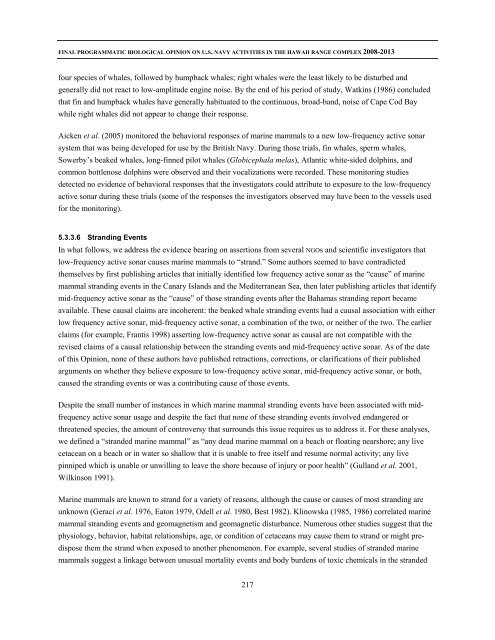NMFS Biological Opinion on U.S. Navy training ... - Govsupport.us
NMFS Biological Opinion on U.S. Navy training ... - Govsupport.us
NMFS Biological Opinion on U.S. Navy training ... - Govsupport.us
You also want an ePaper? Increase the reach of your titles
YUMPU automatically turns print PDFs into web optimized ePapers that Google loves.
FINAL PROGRAMMATIC BIOLOGICAL OPINION ON U.S. NAVY ACTIVITIES IN THE HAWAII RANGE COMPLEX 2008-2013<br />
four species of whales, followed by humpback whales; right whales were the least likely to be disturbed and<br />
generally did not react to low-amplitude engine noise. By the end of his period of study, Watkins (1986) c<strong>on</strong>cluded<br />
that fin and humpback whales have generally habituated to the c<strong>on</strong>tinuo<strong>us</strong>, broad-band, noise of Cape Cod Bay<br />
while right whales did not appear to change their resp<strong>on</strong>se.<br />
Aicken et al. (2005) m<strong>on</strong>itored the behavioral resp<strong>on</strong>ses of marine mammals to a new low-frequency active s<strong>on</strong>ar<br />
system that was being developed for <strong>us</strong>e by the British <strong>Navy</strong>. During those trials, fin whales, sperm whales,<br />
Sowerby’s beaked whales, l<strong>on</strong>g-finned pilot whales (Globicephala melas), Atlantic white-sided dolphins, and<br />
comm<strong>on</strong> bottlenose dolphins were observed and their vocalizati<strong>on</strong>s were recorded. These m<strong>on</strong>itoring studies<br />
detected no evidence of behavioral resp<strong>on</strong>ses that the investigators could attribute to exposure to the low-frequency<br />
active s<strong>on</strong>ar during these trials (some of the resp<strong>on</strong>ses the investigators observed may have been to the vessels <strong>us</strong>ed<br />
for the m<strong>on</strong>itoring).<br />
5.3.3.6 Stranding Events<br />
In what follows, we address the evidence bearing <strong>on</strong> asserti<strong>on</strong>s from several NGOs and scientific investigators that<br />
low-frequency active s<strong>on</strong>ar ca<strong>us</strong>es marine mammals to “strand.” Some authors seemed to have c<strong>on</strong>tradicted<br />
themselves by first publishing articles that initially identified low frequency active s<strong>on</strong>ar as the “ca<strong>us</strong>e” of marine<br />
mammal stranding events in the Canary Islands and the Mediterranean Sea, then later publishing articles that identify<br />
mid-frequency active s<strong>on</strong>ar as the “ca<strong>us</strong>e” of those stranding events after the Bahamas stranding report became<br />
available. These ca<strong>us</strong>al claims are incoherent: the beaked whale stranding events had a ca<strong>us</strong>al associati<strong>on</strong> with either<br />
low frequency active s<strong>on</strong>ar, mid-frequency active s<strong>on</strong>ar, a combinati<strong>on</strong> of the two, or neither of the two. The earlier<br />
claims (for example, Frantis 1998) asserting low-frequency active s<strong>on</strong>ar as ca<strong>us</strong>al are not compatible with the<br />
revised claims of a ca<strong>us</strong>al relati<strong>on</strong>ship between the stranding events and mid-frequency active s<strong>on</strong>ar. As of the date<br />
of this <str<strong>on</strong>g>Opini<strong>on</strong></str<strong>on</strong>g>, n<strong>on</strong>e of these authors have published retracti<strong>on</strong>s, correcti<strong>on</strong>s, or clarificati<strong>on</strong>s of their published<br />
arguments <strong>on</strong> whether they believe exposure to low-frequency active s<strong>on</strong>ar, mid-frequency active s<strong>on</strong>ar, or both,<br />
ca<strong>us</strong>ed the stranding events or was a c<strong>on</strong>tributing ca<strong>us</strong>e of those events.<br />
Despite the small number of instances in which marine mammal stranding events have been associated with midfrequency<br />
active s<strong>on</strong>ar <strong>us</strong>age and despite the fact that n<strong>on</strong>e of these stranding events involved endangered or<br />
threatened species, the amount of c<strong>on</strong>troversy that surrounds this issue requires <strong>us</strong> to address it. For these analyses,<br />
we defined a “stranded marine mammal” as “any dead marine mammal <strong>on</strong> a beach or floating nearshore; any live<br />
cetacean <strong>on</strong> a beach or in water so shallow that it is unable to free itself and resume normal activity; any live<br />
pinniped which is unable or unwilling to leave the shore beca<strong>us</strong>e of injury or poor health” (Gulland et al. 2001,<br />
Wilkins<strong>on</strong> 1991).<br />
Marine mammals are known to strand for a variety of reas<strong>on</strong>s, although the ca<strong>us</strong>e or ca<strong>us</strong>es of most stranding are<br />
unknown (Geraci et al. 1976, Eat<strong>on</strong> 1979, Odell et al. 1980, Best 1982). Klinowska (1985, 1986) correlated marine<br />
mammal stranding events and geomagnetism and geomagnetic disturbance. Numero<strong>us</strong> other studies suggest that the<br />
physiology, behavior, habitat relati<strong>on</strong>ships, age, or c<strong>on</strong>diti<strong>on</strong> of cetaceans may ca<strong>us</strong>e them to strand or might predispose<br />
them the strand when exposed to another phenomen<strong>on</strong>. For example, several studies of stranded marine<br />
mammals suggest a linkage between un<strong>us</strong>ual mortality events and body burdens of toxic chemicals in the stranded<br />
217








